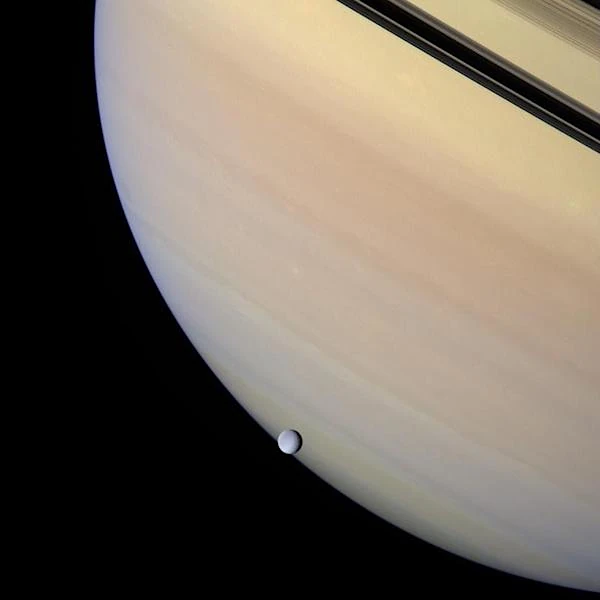
Rhea is Saturn's second-largest moon after Titan, with an average diameter of about 1,527 km and an estimated mass of 2.3 × 1021 kg. Its mean density, close to 1.24 g/cm3, indicates a mostly icy composition with a significant rocky fraction. The surface of Rhea is heavily cratered, showing features such as crater chains and linear fractures, revealing an ancient geological history.
Orbitally, Rhea revolves around Saturn at an average distance of 527,000 km and has synchronous rotation, always showing the same face to the planet. Its orbital period is about 4.5 Earth days. The orbital inclination of 0.35° and the low eccentricity contribute to stable yet significant gravitational interactions with the particles of Saturn's outer rings. Rhea orbits just beyond the E ring. It does not directly influence the main rings (A, B, C, D) but may have a marginal effect on the outer E ring and distant dust through gravitational resonances. Perturbations of the F ring are mainly caused by the nearby moons Prometheus and Pandora.
Rhea's gravitational effects on the rings appear in several forms:
Numerical simulations show that Rhea's presence stabilizes some ring sections while perturbing others. These interactions create a dynamic balance between gravitational forces and interparticle collisions.
| Type of perturbation | Affected zone | Mechanism | Comment |
|---|---|---|---|
| Density wave | Outer A ring | 3:2 orbital resonance with Rhea | Causes local periodic density variations, producing wave patterns in the ring. |
| Low-density zone | Outer B ring | Cumulative gravitational interaction | Particles gradually removed, forming gaps or less dense regions. |
| Orbital modifications | F ring | Tidal forces induced by Rhea | Small changes in particle velocity gradually reshape the ring's structure. |
Source: NASA – Rhea
Rhea is part of a group of medium and outer moons of Saturn that gravitationally interact with the rings and with each other. Its immediate neighbors include Titan, Saturn's second-largest moon, as well as intermediate moons such as Iapetus, Tethys, and Dione. Each moon has a near-circular orbit with low inclination, forming a complex network of orbital resonances and mutual perturbations.
The orbital distances between these satellites are large enough to prevent direct collisions, but cumulative gravitational effects gradually modify trajectories and orbital velocities, influencing the stability of Saturn's outer rings. Rhea, with its intermediate mass, acts as a modulator of perturbations induced by Titan and Iapetus, participating in the overall dynamics of the system.
Comparative analysis of physical and orbital properties of these moons also reveals significant differences in composition and structure. Rhea and Tethys are mostly icy, while Iapetus shows a marked dichotomy between a bright and a dark hemisphere.
| Moon | Diameter (km) | Mass (kg) | Average orbital distance (km) | Density (g/cm3) | Particularities |
|---|---|---|---|---|---|
| Rhea | 1,527 | 2.3 × 1021 | 527,000 | 1.24 | Heavily cratered surface, mostly ice |
| Tethys | 1,062 | 6.2 × 1020 | 294,000 | 0.98 | Large icy plains, Odysseus crater |
| Dione | 1,123 | 1.1 × 1021 | 377,000 | 1.48 | Combination of icy and cratered terrains, linear fractures |
| Iapetus | 1,471 | 2.2 × 1021 | 3,561,000 | 1.27 | Bright/dark dichotomy, synchronous rotation |
| Titan | 5,151 | 1.35 × 1023 | 1,222,000 | 1.88 | Dense atmosphere, cryovolcanism |
Source: NASA – Solar System Exploration